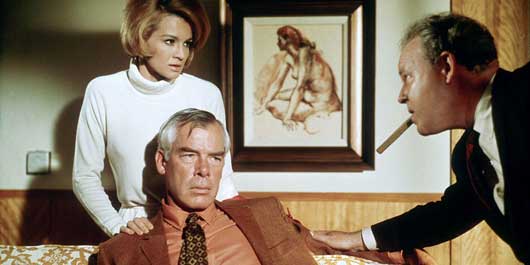
When John Boorman took his idea to the studio for a film version of pulp book The Hunter, he was accused of having gone mad. When the studio saw the rushes of one scene, in which seven men talk in a green office wearing green suits, green shirts and green ties, they thought he’d totally lost it. Boorman would have the last laugh as Point Blank is one of the most iconic, powerful films of the 1960s, and still looks fantastic. If you want to know where the style for Mad Men came from, it started here.
The terrible script actually brought Boorman and Lee Marvin together they both read it, both hated it, but Marvin negotiated a deal letting Boorman have carte blanche. The result is a head-scratcher of a thriller with an extraordinary visual architecture and dream-like feel to it.
Marvin plays a crook, Walkere, shot in the opening seconds in his cell in Alcatraz. We then fast forward to him plotting revenge it seems he was part of a gang who stole cash from The Organisation’ but he never got his share and he stalks the man who took it Mal Reese, who is also sleeping with his wife. What follows is a classic one-man-against-the-system thriller, with Marvin battering, punching and shooting his way across a brutalist-looking Los Angeles to get his man and his cash.
His only ally is Dickinson’s Chris, an uber-sexy, cool woman every bit as tough and manipulative as Walker. They fire sparks off each other but stick together in one classic scene she beats and flays at Walker, who stands there as impassive as a tennis umpire facing a McEnroe-esque rant.
The ingredient that makes this such a stand-out thriller is the psychological slant Boorman gives the whole film. It is fragmented, nonsensical, and leaps backwards and forwards so much that we never know if this is actually happening or if it’s Walker’s dying wish fulfilment. He repeats the line It seemed like a dream’ several times, and a cocktail waitress at one point says Walker are you still alive?’.
Boorman’s visuals matches his dream-like ideas, with Los Angeles looking like a bleached-out, brutalist, concrete nightmare in which there are plenty of places to hide, even in daylight but especially at night, even with all that neon lighting.
Marvin is never better than here, his lantern-jawed features and white hair giving him the perfect spectre-like appearance, and Dickinson is just plain gorgeous, in a very 1960s way. Gone is the ditsiness of stars like Monroe or Russell, replaced by a hard-nosed woman who knows what she wants.
Overall verdict: Welcome reissue of one of the cornerstones of 1960s thrillers, well worth another look for the dream-like feel.
Reviewer: Mike Martin